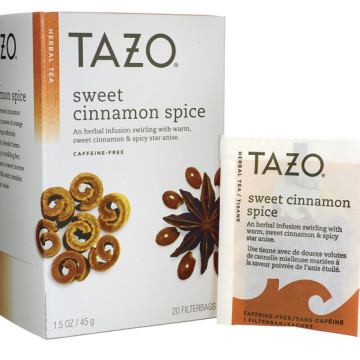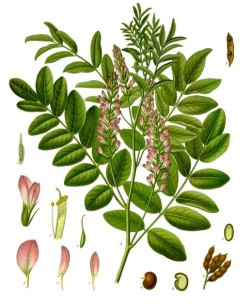 Searching for a guilt-free treat during the holidays, I discovered a delicious tea by Tazo called Sweet Cinnamon Spice. The box has a very tempting arrangement of swirly cinnamon buns–the kind of food I’d never let myself actually eat for a host of reasons–and part of me doubted the tea would live up to this surely hyperbolic marketing tactic.
Searching for a guilt-free treat during the holidays, I discovered a delicious tea by Tazo called Sweet Cinnamon Spice. The box has a very tempting arrangement of swirly cinnamon buns–the kind of food I’d never let myself actually eat for a host of reasons–and part of me doubted the tea would live up to this surely hyperbolic marketing tactic.
Boy, was I wrong. The combination of sweet and spicy notes only needed a splash of soy milk to be transformed into a liquid dessert. It was tea-vana.
Curious as to what made this brew so magical, I read through the ingredients and discovered the answer: licorice root. I knew that I recognized something from my favorite vegetable, fennel, in my cup. Although fennel and licorice are not the same plant, they do contain the same flavor compounds. The sweetness they share comes from glycrrhizin, which is 30-50 times sweeter than sugar but has a more lasting flavor. That’s why my tea kept (and will keep) me satisfied long after my fellow revelers’ sugar-comas started to set in.
Licorice can be incorporated into your diet numerous ways, and it does more than satisfy a sweet tooth. There’s obviously licorice candy, but while a Twizzler might amuse you for a few minutes it actually contains very little licorice itself. Purer forms come from the plant, which grows in the Middle East and East Asia, where it’s been an herbal remedy for centuries: the Chinese use it as a “harmonizing” ingredient, and in Ayurveda it is used to relieve respiratory and digestive problems.
 Dried leaves can be used for teas or as a spice (also available this way in capsules). Preparing three cups of licorice tea per day can combat a variety of health ailments, including athlete’s foot, chronic fatigue, respiratory problems (cough or cold), ulcers, acid reflux, indigestion, canker sores, and even aid in weight loss. The tea combinations are endless and can be a welcome change to stand-by remedies for these problems like mint and ginger tea. (I recently found a great Egyptian Licorice Mint blend, by Yogi.)
Dried leaves can be used for teas or as a spice (also available this way in capsules). Preparing three cups of licorice tea per day can combat a variety of health ailments, including athlete’s foot, chronic fatigue, respiratory problems (cough or cold), ulcers, acid reflux, indigestion, canker sores, and even aid in weight loss. The tea combinations are endless and can be a welcome change to stand-by remedies for these problems like mint and ginger tea. (I recently found a great Egyptian Licorice Mint blend, by Yogi.)
The roots can also be boiled, which turns into a solid or a syrup. Licorice extract can be added to beverages or foods for the above ailments or as a flavor boost to a favorite dish. Try adding it to savory stew or stir-fry to compliment ginger and garlic; and it’s a no-brainer for desserts, like Licorice Fudge, made by simply combining 1 1/3 cups pecans, 4 T. of agave nectar or honey, and 3 t. licorice powder in a food processor and refrigerating until firm.
Little research has been conducted on the efficacy of licorice as a medical treatment, so consult your doctor if you consider doing so. In fact, licorice shouldn’t be consumed regularly (more than 50 grams per day) for more than 4-6 weeks as it could cause headaches, water retention, and a rise in blood pressure; pregnant women should also avoid licorice as it affects the IQ and behavior of a fetus. But in moderation, as most good things are, licorice is a wonderful way to add health and variety to your routine.
__
Photo: Tazo; Ryan Opaz via Flickr; Franz Eugen Köhler, Köhler’s Medizinal-Pflanzen





